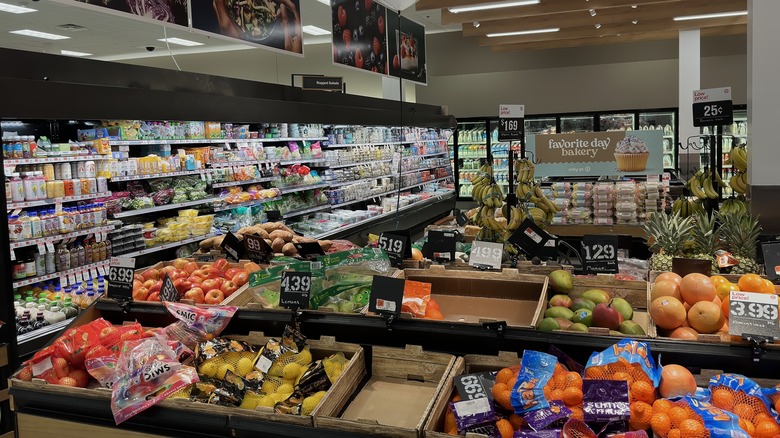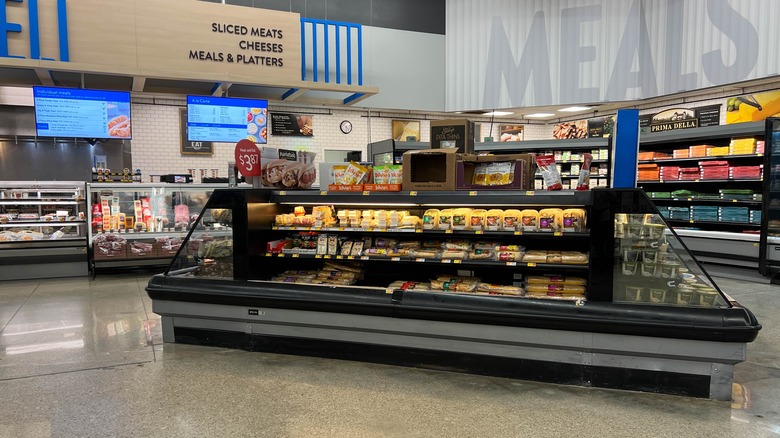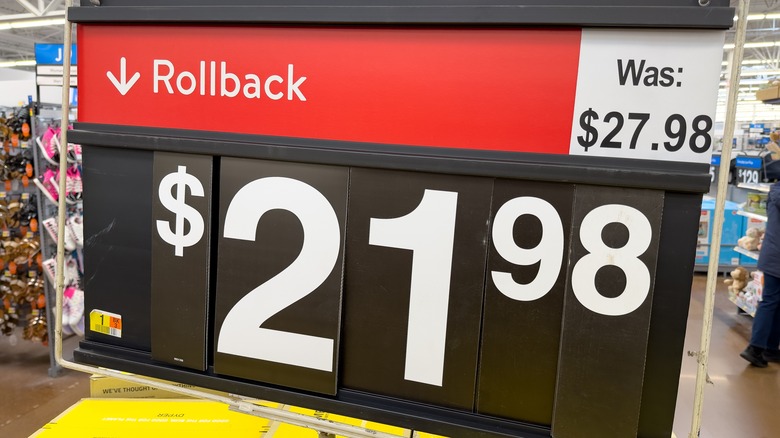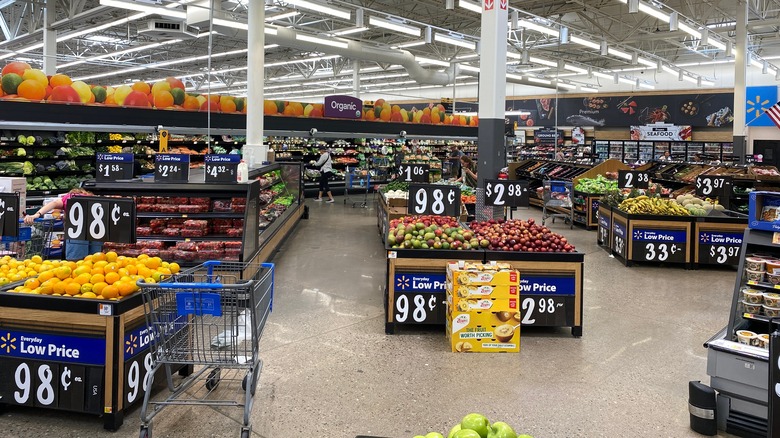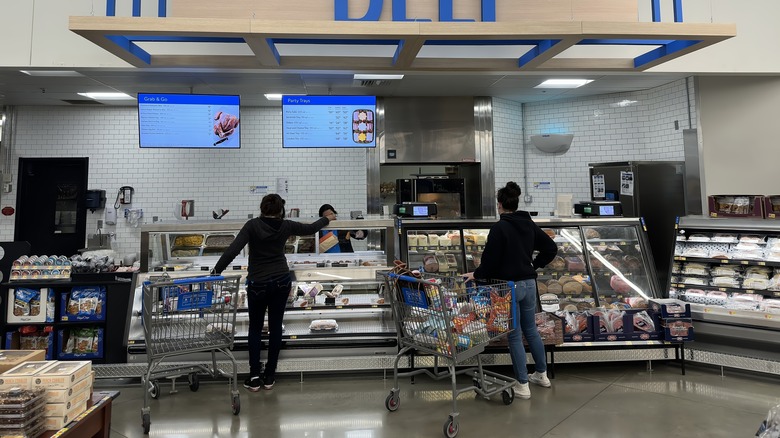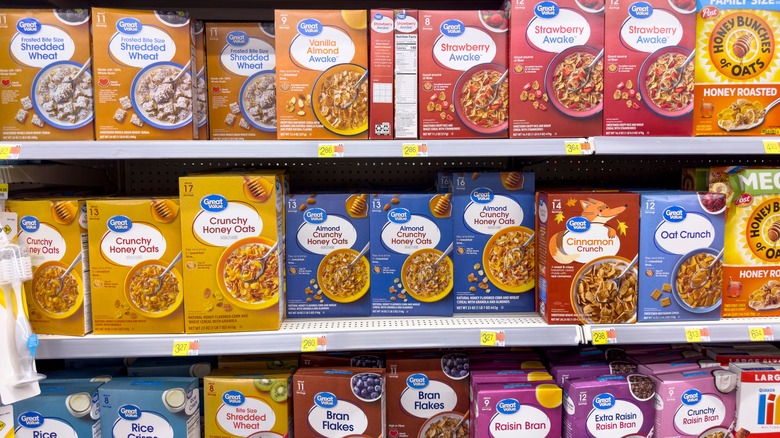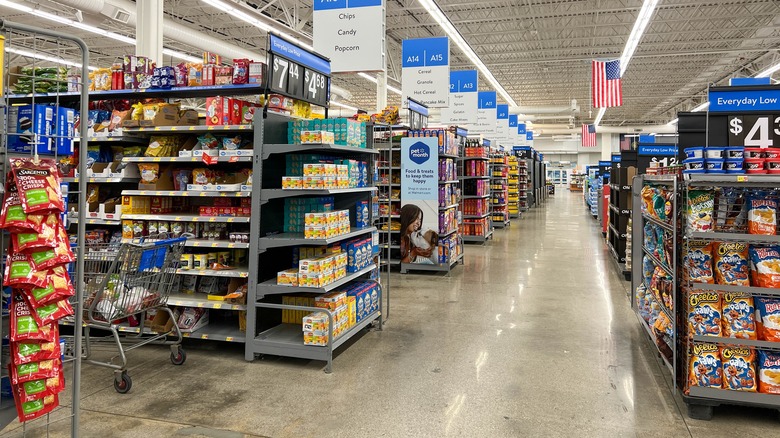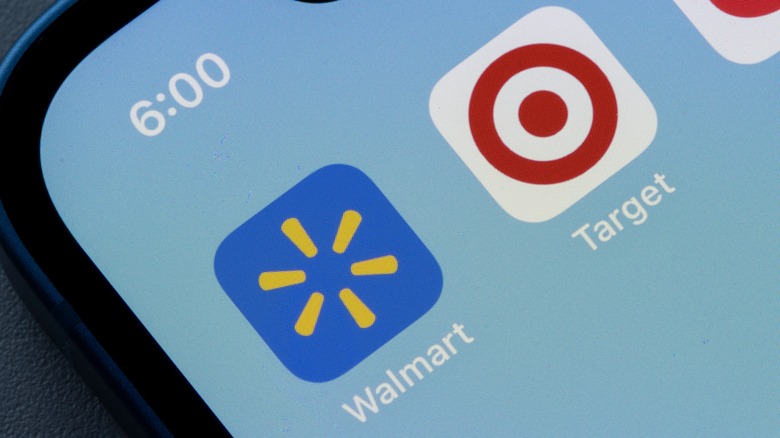Walmart Vs Target: Where To Buy The Best And Cheapest Groceries?
We may receive a commission on purchases made from links.
Walmart and Target have become regular stops for many shoppers looking for a bargain on groceries. For those lucky enough to live near both, it may seem like each has a wealth of deals and low prices. But as high prices overall take more out of your paycheck, it becomes more important to figure out just how much of a deal you're getting and whether you could get a better one, even by a few cents.
Both companies approach groceries in somewhat different ways, and there's no one answer that will satisfy everyone. However, that doesn't mean that those differences won't have an effect on your wallet. It's also crucial to note that prices, while obviously important, aren't all that you should take into consideration if you want to find the "best" and "cheapest" groceries, especially if you live in a region with high gas prices, for example. Here's a look at Walmart, Target, and which one has the better deals.
How Target approaches groceries
In many Target locations, you can buy most of the same types of food as in a regular grocery store, but groceries are essentially one section out of many. Target is often seen as a department store that happens to sell food, and in fact, it calls itself a "general merchandise retailer," not a grocery store.
When Target began a major expansion of its fresh food selections in 2010, the initial goal was to cater to those who needed a convenient way to pick something up fast or get items that they needed in between regular grocery shopping trips. The intent then was not to replace supermarkets or become everyone's favorite grocery store, and shoppers took to it so easily that even now, that's how they see the store. In 2023, food and beverage accounted for only about 23% of Target's revenue, according to the company's annual report, with the store being more of a "top-up" type of shopping trip.
How Walmart approaches groceries
Walmart has three formats, and depending on which one you shop at, you could encounter everything from a big-box store with some food to a full-stop grocery store. In regular Walmarts, or "Discount Stores," the approach is similar to Target's but often scaled down. There may be a substantial number of aisles with shelf-stable goods, but refrigerated and frozen items often get only one to two aisles, with no fresh foods other than maybe a few offerings in the refrigerated cases. In Walmart Supercenters and Neighborhood Markets, the approach is that of having an actual grocery store, either as the main purpose of the location (Neighborhood Markets) or as a major part of the store (Supercenters). If you wander into a Discount Store intending to do your full weekly grocery shopping, you'll be disappointed.
Walmart is often seen as a grocery store and big-box retailer; the term "hypermarket" fits the Supercenters well, although Walmart tends not to use this term (at least not in the U.S.). Groceries make up a substantial portion of the company's profits; according to the company's annual report, groceries were approximately 59% of Walmart's revenue in 2023, and that revenue placed Walmart at the top of the U.S. grocery food chain.
Target Circle and Walmart
Both Target and Walmart try to offer low prices in general, but they take it a step further with special discount memberships. Target has its Circle program and credit card (this was formerly known as the Target Red Card), and Walmart has Walmart+. Both programs have undergone changes in 2024, but the benefits are that Target Circle and the Circle card let you save a certain percentage on current and future purchases when you join, while Walmart+ lets you save on more general features like shipping.
Target Circle has different membership levels; one is free. In general, you'll get special sales and specific discounts for events like your birthday. You'll also earn toward future purchases. There's also the Circle card, which gives you an extra 5% off many items. Add in free shipping and other perks at the paid levels, and Circle can really bring down your grocery bill.
Walmart+ plans are paid memberships that include discounts on gas, free delivery, the use of the mobile scan & go feature, travel discounts, and even a free Paramount+ membership. Walmart used to have a deal with Capital One for two different credit cards that offered rewards and savings on purchases. However, this partnership ended in 2024. Current cardholders still have access to those savings, but no new cards are being issued, which means Target Circle currently offers better prices for your shopping list.
Rollbacks and price cuts
If you don't want anything to do with programs that require fees or sign-ups, you can still take advantage of sales. Target has an online weekly ad with savings; this gives you a chance to stock up on items like you would at any other store. Walmart doesn't have a traditional weekly ad, but you can browse grocery deals on one web page and see deals under $5 on another. Sale prices are typically listed in green, and some also have a red "rollback" tag. (It's difficult to give you a winner in terms of which company has more sales as these prices change constantly, but these are all worth checking out before you make your grocery list.)
By the way, in May 2024, both Walmart and Target announced they'd be cutting prices on thousands of items. Target's reasoning was that customers needed lower prices to help them deal with widespread inflation elsewhere, while Walmart pointed to deflation for general items and efforts by suppliers to lower food prices. The cuts themselves seem small, such as $0.20 here and $1 there, but they do add up. This is an evolving situation with some cuts yet to be made, so keep a close eye on the products that you like to buy. Note that the price drops aren't limited to store brands, although those do make up the bulk of the cuts.
Fresh produce
Both Walmart and Target carry fresh produce, but Walmart wins over Target for pricing. Surveys continually show produce at Walmart to be cheaper than produce at Target for most items. For example, Tradingpedia found a $0.02 difference for individual bananas in 2023, and AARP found a $0.23 difference for bananas (per pound) in 2024. There are rare exceptions, but Walmart's where you want to go to save on produce if money is your only concern. That said, you may want to look farther down the page at the section on product quality for additional information.
Walmart occasionally has produce that Target doesn't, depending on what the manager of a particular store may have opted to carry. For example, the Supercenter in Poway, California sometimes has opo squash, a.k.a. calabash, which isn't something you'd usually find at Target. Of course, this can always change, but it's a hint that in this case, Walmart may be the place to look first if you need produce that tends to be harder to find.
Specialty sections
Depending on the store format, many Walmart locations have deli counters that make products like rotisserie chickens and wraps. Supercenters even have bakery counters where you can get customized cakes. And many stores, especially the Neighborhood Markets, have extensive raw-meat sections. If you want to do all your grocery shopping at one store, a Walmart Neighborhood Market or Supercenter will have the best selection and give you the most "grocery store"-like experience. For someone who doesn't have the time or ability to go to multiple markets for different items, this is important.
Target is different. Many Target stores are what's called "general merchandise," meaning there are no grocery sections offering fresh food. A variety of store layout called "P-fresh" is a step up; this has a grocery section that's limited and that may have some fresh food, but no specialty sections. SuperTarget layouts are supposed to have specialty sections like bakeries, akin to a Walmart Supercenter, but these aren't in every city. In fact, the location page on the Target website doesn't list stores by layout, so finding a SuperTarget is not very easy unless you're lucky enough to live near one.
Generic/store brand options
Store brands, or private labels, are meant to give customers quality that's similar to name-brand products, just at a lower price. In general, Walmart tends to get the better reviews in this situation before any discount program benefits are applied, but this is one time when price isn't the only factor to consider.
You also want to look at the number of options you have within those brands. If one store has lower prices on paper towels but offers only two or three varieties that don't really fit your needs, while another store has slightly higher prices but offers twice that number plus occasional special versions, the lower prices at the first store won't matter. And Target does shine when it comes to certain types of food, with selections that are either more extensive than Walmart's or that have more eclectic choices. For example, Target recently offered a strawberry cream-flavored coffee under its Good & Gather label. If you look for that flavor at Walmart, you might find it online — but the only "store brand" version is from Good & Gather.
Price matching
Both Target and Walmart offer price matching, which is very, very helpful if you can keep track of the prices at different stores. Price matching is the practice of lowering a price to match that of the same product at a different store, usually as a way to keep a customer at your store and stop them from going to the other store to buy the item. Price matching can be done on just about anything if a store's policy allows it, from food to prescription medication.
Unfortunately, Walmart's price matching policy is restrictive. The company doesn't match prices from competitors, nor does it match prices between Walmart stores. So, if one store lists a product at a clearance price — managers at different locations can set their own prices for clearance — another store that isn't putting that product on clearance won't match the price. The company will match certain prices from Walmart.com in store.
Target has a wider price match policy that does include some competitors. However, the competitors have to be from a select list, and believe it or not, that list does include Walmart.com (you can pull up the list in a pop-up from their price-match policy page). Target won't match prices on products bought at another Target where the price may have been lower, however. So, Target has a slight edge over Walmart if the lower price you found is from certain online retailers.
The cost of gas
Something people often forget to figure into their grocery bill is the cost of the transportation to get to the store and back. As with anything else, this is highly variable and based on your personal situation. However, it's good to keep in mind that the amount of gas you use, the price of gas in your region, the cost of public transportation, and how much walking you can do all factor into the overall dollar amount that you spend when shopping. In general, it's easier to find a Walmart than a Target. As of February 2024, Target had nearly 2,000 locations in the United States; as of April 2024, Walmart had 4,609 locations (not counting Sam's Club).
You've got a better chance of living close to a Walmart in general, although it might not be a Neighborhood Market or Supercenter. Still, the store formats tend to appear in groups, at least in some cities; you might live near a Discount Store but have access to a Supercenter a few miles away, for example, with a Neighborhood Market a few miles away in another direction. Some stores are very close together, such as in Escondido, California, where a Neighborhood Market and Discount Store are only a half mile apart, and that's if you don't cut through parking lots. Of course, if you live within a few blocks of a Target and a few miles from the nearest Walmart, your costs may end up being very different.
Product quality
Low prices don't matter if you don't want to buy the product due to a perceived issue with quality. And unfortunately, the impression many people voice of Walmart is that there are more quality issues with things like their packaging, such as finding bags of frozen vegetables with a corner torn open. Produce may stay on the shelves for a longer time and end up looking rather sorry, although a big bonus at Walmart is that these products often get marked down just before their best-by date (look for those large yellow price stickers). Produce may not adhere to what you consider great, although this can be a personal choice, such as preferring broccoli to have more florets than stem or more stem than florets; finding one when you prefer the other will color your views toward the store. Anecdotal reports show more returns to Walmart for product quality, too.
Target's overall quality is (at least anecdotally) considered to be better. Shoppers have observed that the stores are more likely to be neat, while Walmart stores can vary from very tidy and organized to rather messy. Products at Target seem (again, anecdotally) to be of higher quality with fewer old items on the shelves, and sometimes better-tasting produce. This may be because of the types of items the stores sell and their respective customer bases; for example, Walmart's push to get very inexpensive products for customers on strict budgets can result in less-fancy packaging and more basic quality.
If you're including household care as part of groceries
If you consider personal and household care products to be a part of your "grocery" budget, you may want to give Target a good look. It seems to get the bulk of the praise, especially once you figure in things like Circle discounts. Baby formula, paper goods, laundry goods — Walmart tends to win in terms of basic prices, but once the Target Circle discounts are factored in, Target prices quickly drop.
For example, at the time of this writing at stores in north Austin, Texas, the same variety of Johnson and Johnson Baby Shampoo was $2.47 at Walmart and $2.59 at Target, before any discounts. Two rolls (220 sheets) of Great Value Everyday paper towels sold for $2.38, or $1.08 per 100 sheets; two rolls (300 sheets) of up&up paper towels sold for $4.99, or $1.66 per 100 sheets.
Walmart prices on store-brand, non-food items that you'd normally find at grocery stores tend to beat those at Target before discounts. This isn't 100% the case, and you can find items where Target has lower prices. But if you're going to shop without signing up for a discount program, Walmart is likely less expensive overall. But, if you're not opposed to signing up for a discount program, Target may end up being better. Again, this depends on which individual products you prefer. In any case, keep an eye out for store deals and manufacturer coupons at both stores.
Overall selection
For someone who needs to do their grocery shopping and who needs to save as much money as possible while having the widest selection available, Walmart appears to be the winner. This company treats groceries as groceries and sets up many of its stores as either grocery stores or partial grocery stores. Target's prices and selection are great for those in the Circle program or who are just looking for some items on their grocery list in addition to other department-store style items, like bath goods. If you're limited to going to just one store, especially on a strict budget, Walmart may be more helpful, especially if you keep an eye on price rollbacks.
But if you can go to both, the winner becomes less clear. Target's discounts on some items may be better, and the selection of impulse goods may be wider, if you like seeing those. The overall atmosphere at Target usually gets compliments, whereas the shopping experience at Walmart tends to be very location-dependent. If your definition of "best and cheapest" includes stress levels, ease of access, and how fashionable a product may be, Target is a real contender.
Remember that both stores are in competition with each other and are constantly changing products and prices — and customer behavior and store staffing levels often play a huge role in what sort of impression the stores give shoppers. Plus, keep in mind that what you find can change quickly.
Methodology
Comparing prices and quality at two very large companies — especially those that have multiple store formats — isn't going to produce one verdict that everyone can get behind. Someone who lives near a huge Target and a Walmart Discount Store is going to think the better selection of produce is at Target, while someone who lives near a Neighborhood Market would likely disagree. But you can see what the majority says and come up with a general idea of where to go or what to look out for.
For this article, we looked at existing comparisons from major consumer, food, budgeting, lifestyle, and news websites — one of which showed how important it was to understand Walmart's store formats before venturing into them — plus opinions and complaints on everyone's favorite global forum, Reddit. In addition to looking at what others thought, we also put over two decades of personal experience shopping at both stores to use and looked at the stores' current prices.
Saving money and spending it wisely when these stores are your options may initially take a few trips back and forth, plus some time searching both websites. You'll quickly figure out which stores in your area fill your particular needs.

